The Injected Foaming Study of Polypropylene/Multiwall Carbon Nanotube Composite with In Situ Fibrillation Reinforcement
Abstract
1. Introduction
2. Experimental
2.1. Materials
2.2. The Preparation of PP/PTFE Composites
2.3. The Preparation of PP–g–MA–MWCNTs Composite
2.4. Masterbatch Preparation
2.5. The Preparation of PP/PTFE/MWCNTs Composite
2.6. PP/PTFE/MWCNTs Composite Injection Foaming
2.7. Morphological Characterization
2.7.1. TEM
2.7.2. SEM
2.8. DSC Analysis
2.9. Rheology Test
2.10. Density Test
2.11. Tensile Stress
2.12. Conductivity Test
3. Results and Discussion
3.1. TEM
3.2. SEM
3.3. DSC
3.4. Rheology
3.5. Foam Density
3.6. Tensile Testing
3.7. Conductivity Test
4. Conclusions
Author Contributions
Funding
Conflicts of Interest
References
- Lyu, M.Y.; Choi, T.G. Research trends in polymer materials for use in lightweight vehicles. Int. J. Precis. Eng. Manuf. 2015, 16, 213–220. [Google Scholar] [CrossRef]
- Friedrich, K.; Almajid, A.A. Manufacturing Aspects of Advanced Polymer Composites for Automotive Applications. Appl. Compos. Mater. 2013, 20, 107–128. [Google Scholar] [CrossRef]
- Volpe, V.; Lanzillo, S.; Affinita, G.; Villacci, B.; Macchiarolo, I.; Pantani, R. Lightweight high-performance polymer composite for automotive applications. Polymers 2019, 11, 326. [Google Scholar] [CrossRef]
- Patil, A.; Patel, A.; Purohit, R. An overview of polymeric materials for automotive applications. Mater. Today Proc. 2017, 4, 3807–3815. [Google Scholar] [CrossRef]
- Kuang, T.; Ju, J.; Chen, F.; Liu, X.; Zhang, S.; Liu, T.; Peng, X. Coupled effect of self-assembled nucleating agent, Ni-CNTs and pressure-driven flow on the electrical, electromagnetic interference shielding and thermal conductive properties of poly (lactic acid) composite foams. Compos. Sci. Technol. 2022, 230, 109736. [Google Scholar] [CrossRef]
- Ju, J.; Gu, Z.; Liu, X.; Zhang, S.; Peng, X.; Kuang, T. Fabrication of bimodal open-porous poly (butylene succinate)/cellulose nanocrystals composite scaffolds for tissue engineering application. Int. J. Biol. Macromol. 2020, 147, 1164–1173. [Google Scholar] [CrossRef] [PubMed]
- Fei, Y.; Chen, F.; Fang, W.; Hejna, A.; Xu, L.; Liu, T.; Zhong, M.; Yang, J.; Kuang, T. Conductive thermoplastic polyurethane nanocomposite foams derived from a cellulose/MWCNTs aerogel framework: Simultaneous enhancement of piezoresistance, strength, and endurance. J. Mater. Chem. C 2021, 9, 13103–13114. [Google Scholar] [CrossRef]
- Fei, Y.; Chen, F.; Fang, W.; Xu, L.; Ruan, S.; Liu, X.; Zhong, M.; Kuang, T. High-strength, flexible and cycling-stable piezo-resistive polymeric foams derived from thermoplastic polyurethane and multi-wall carbon nanotubes. Compos. Part B Eng. 2020, 199, 108279. [Google Scholar] [CrossRef]
- Ju, J.; Kuang, T.; Ke, X.; Zeng, M.; Chen, Z.; Zhang, S.; Peng, X. Lightweight multifunctional polypropylene/carbon nanotubes/carbon black nanocomposite foams with segregated structure, ultralow percolation threshold and enhanced electromagnetic interference shielding performance. Compos. Sci. Technol. 2020, 193, 108116. [Google Scholar] [CrossRef]
- Liu, T.; Ju, J.; Chen, F.; Wu, B.; Yang, J.; Zhong, M.; Peng, X.; Kuang, T. Superior mechanical performance of in-situ nanofibrillar HDPE/PTFE composites with highly oriented and compacted nanohybrid shish-kebab structure. Compos. Sci. Technol. 2021, 207, 108715. [Google Scholar] [CrossRef]
- Li, L.; Li, W.; Geng, L.; Chen, B.; Mi, H.; Hong, K.; Peng, X.; Kuang, T. Formation of stretched fibrils and nanohybrid shish-kebabs in isotactic polypropylene-based nanocomposites by application of a dynamic oscillatory shear. Chem. Eng. J. 2018, 348, 546–556. [Google Scholar] [CrossRef]
- Huang, Z.; Shi, C.; Enick, R.; Beckman, E. Generation of microcellular materials via self-assembly in carbon dioxide. Chem. Mater. 2002, 14, 4273–4280. [Google Scholar] [CrossRef]
- Rizvi, A.; Andalib, Z.K.M.; Park, C.B. Fiber-spun polypropylene/polyethylene terephthalate microfibrillar composites with enhanced tensile and rheological properties and foaming ability. Polymer 2017, 110, 139–148. [Google Scholar] [CrossRef]
- Jurczuk, K.; Galeski, A.; Piorkowska, E. All-polymer nanocomposites with nanofibrillar inclusions generated in situ during compounding. Polymer 2013, 54, 4617–4628. [Google Scholar] [CrossRef]
- Jurczuk, K.; Galeski, A.; Morawiec, J. Effect of poly(tetrafluoroethylene)nanofibers on foaming behavior of linear and branched polypropylenes. Eur. Polym. J. 2017, 88, 171–182. [Google Scholar] [CrossRef]
- Rizvi, A.; Tabatabaei, A.; Barzegari, M.R.; Mahmood, S.H.; Park, C.B. In situ fibrillation of CO2-philic polymers: Sustainable route to polymer foams in a continuous process. Polymer 2013, 54, 4645–4652. [Google Scholar] [CrossRef]
- Zhao, J.; Zhao, Q.; Wang, C.; Guo, B.; Park, C.B.; Wang, G. High thermal insulation and compressive strength polypropylene foams fabricated by high-pressure foam injection molding and mold opening of nano-fibrillar composites. Mater. Design. 2017, 131, 1–11. [Google Scholar] [CrossRef]
- Zhao, J.; Wang, G.; Zhang, L.; Li, B.; Wang, C.; Zhao, G.; Park, C.B. Lightweight and strong fibrillary PTFE reinforced polypropylene composite foams fabricated by foam injection molding. Eur. Polym. J. 2019, 119, 22–31. [Google Scholar] [CrossRef]
- Wang, G.; Zhao, G.; Zhang, L.; Mu, Y.; Park, C.B. Lightweight and tough nanocellular PP/PTFE nanocomposite foams with defect-free surfaces obtained using in situ nanofibrillation and nanocellular injection molding. Chem. Eng. J. 2018, 350, 1–11. [Google Scholar] [CrossRef]
- Zhao, J.; Qiao, Y.; Wang, G.; Wang, C.; Park, C.B. Lightweight and tough PP/talc composite foam with bimodal nanoporous structure achieved by microcellular injection molding. Mater. Design. 2020, 195, 109051. [Google Scholar] [CrossRef]
- Zhao, J.; Wang, G.; Chen, Z.; Huang, Y.; Wang, C.; Zhang, A.; Park, C.B. Microcellular injection molded outstanding oleophilic and sound-insulating PP/PTFE nanocomposite foam. Compos. Part B 2021, 215, 108761. [Google Scholar] [CrossRef]
- Zhang, A.; Chai, J.; Yang, C.; Zhao, J.; Zhao, G.; Wang, G. Fibrosis mechanism, crystallization behavior and mechanical properties of in-situ fibrillary PTFE reinforced PP composites. Mater. Design. 2021, 211, 110157. [Google Scholar] [CrossRef]
- Zhao, J.; Zhao, Q.; Wang, L.; Wang, C.; Guo, B.; Park, C.B.; Wang, G. Development of high thermal insulation and compressive strength BPP foams using mold-opening foam injection molding with in-situ fibrillated PTFE fibers. Eur. Polym. J. 2018, 98, 1–10. [Google Scholar] [CrossRef]
- Zhao, J.; Wang, G.; Zhu, W.; Zhou, H.; Weng, Y.; Zhang, A.; Dong, G.; Zhao, G. Lightweight and strong polypropylene/talc/polytetrafluoroethylene foams with enhanced flame-retardant performance fabricated by microcellular foam injection foaming. Mater. Design. 2022, 215, 110539. [Google Scholar] [CrossRef]
- Chai, J.; Wang, G.; Zhang, A.; Dong, G.; Li, S.; Zhao, J.; Zhao, G. Microcellular injection molded lightweight and tough poly (L-lactic acid)/in-situ polytetrafluoroethylene nanocomposite foams with enhanced surface quality and thermally-insulating performance. Int. J. Biol. Macromol. 2022, 215, 57–66. [Google Scholar] [CrossRef]
- Kakroodi, A.R.; Kazemi, Y.; Rodrigue, D.; Park, C.B. Facile production of biodegradable PCL/PLA in situ nanofibrillar composites with unprecedented compatibility between the blend components. Chem. Eng. J. 2018, 351, 976–984. [Google Scholar] [CrossRef]
- Wu, G.; Xu, Y.; Chen, J.; Dang, K.; Yang, W.; Xie, P. In situ fibrillation-reinforced polypropylene-based multicomponent foams. Polym. Adv. Technol. 2021, 32, 4052–4060. [Google Scholar] [CrossRef]
- Wu, G.; Song, R.; Ma, Y.; Xie, J.; Yang, W.; Xie, P. Polypropylene-based in situ fibrillation-reinforced ternary composite foams with improved filler-phase dispersion. Polym. Eng. Sci. 2022, 62, 373. [Google Scholar] [CrossRef]
- Antonioli, D.; Sparnacci, K.; Laus, M.; Boarino, L.; Righetti, M.C. Polycarbonate-based composites reinforced by in situ polytetrafluoroethylene fibrillation: Preparation, thermal and rheological behavior. J. Appl. Polym. Sci. 2015, 132, 112–123. [Google Scholar] [CrossRef]
- Shahnooshi, M.; Javadi, A.; Nazockdast, H.; Altstädt, V. Development of in situ nanofibrillar poly (lactic acid)/poly (butyleneterephthalate) composites: Non-isothermal crystallization and crystal morphology. Eur. Polym. J. 2020, 125, 109489. [Google Scholar] [CrossRef]
- Ali, M.A.B.M.; Nobukawa, S.; Yamaguchi, M. Morphology development of polytetrafluoroethylene in a polypropylene melt (IUPAC Technical Report). Pure Appl. Chem. 2011, 83, 1819–1830. [Google Scholar] [CrossRef]
- Rizvi, A.; Tabatabaei, A.; Vahedi, P.; Mahmood, S.H.; Park, C.B. Non-crosslinked thermoplastic reticulated polymer foams from crystallization-induced structural heterogeneities. Polymer 2018, 135, 185–192. [Google Scholar] [CrossRef]
- Rizvi, A.; Chu, R.K.; Lee, J.H.; Park, C.B. Superhydrophobic and oleophilic open-cell foams from fibrillar blends of polypropylene and polytetrafluoroethylene. ACS Appl. Mater. Interfaces 2014, 6, 21131–21140. [Google Scholar] [CrossRef]
- Krache, R.; Benavente, R.; López-Majada, J.M.; Pereña, J.M.; Cerrada, M.L.; Pérez, E. Competition between α, β, and γ polymorphs in a β-nucleated metallocenic isotactic polypropylene. Macromolecules 2007, 40, 6871–6878. [Google Scholar] [CrossRef]

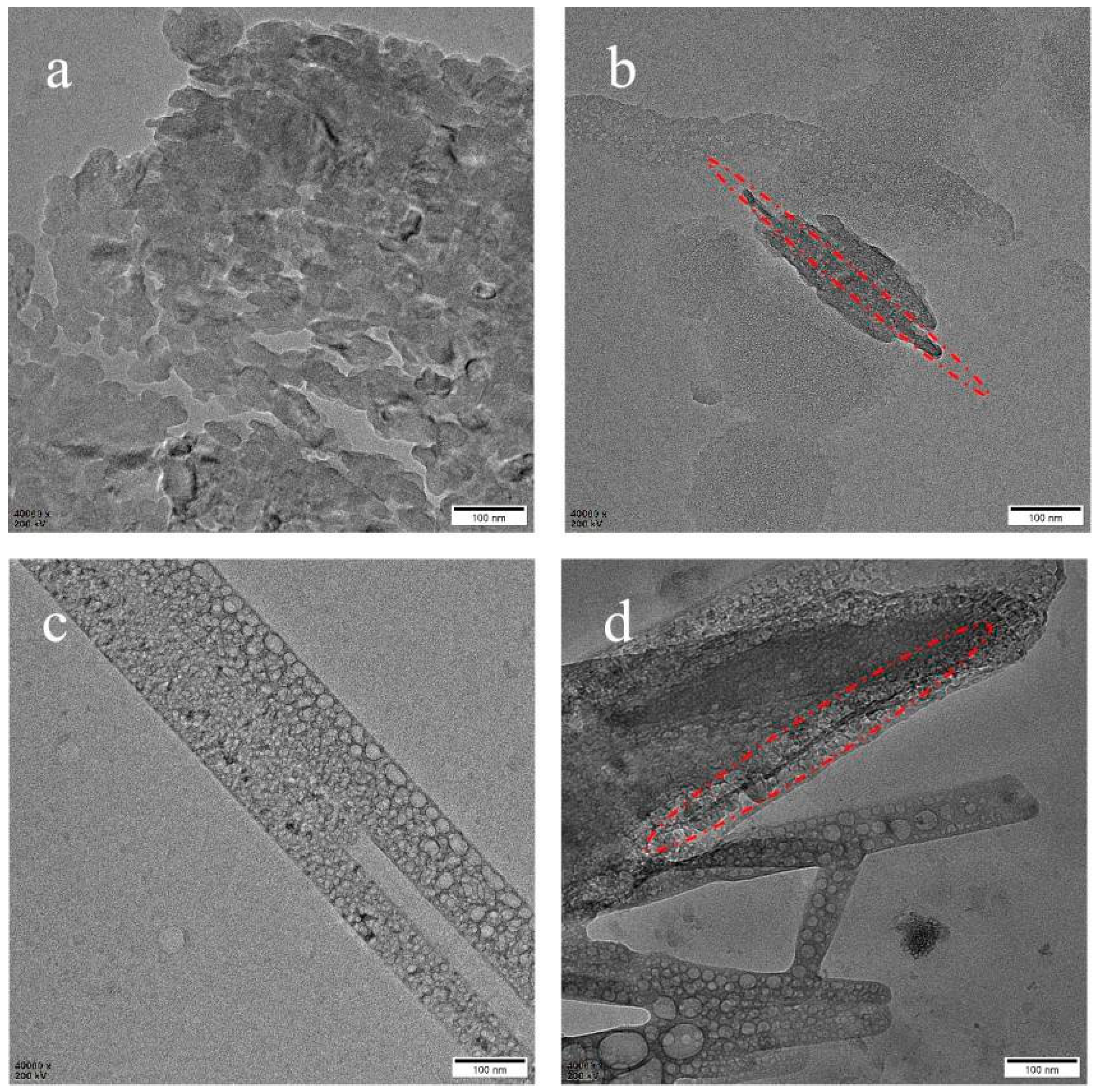

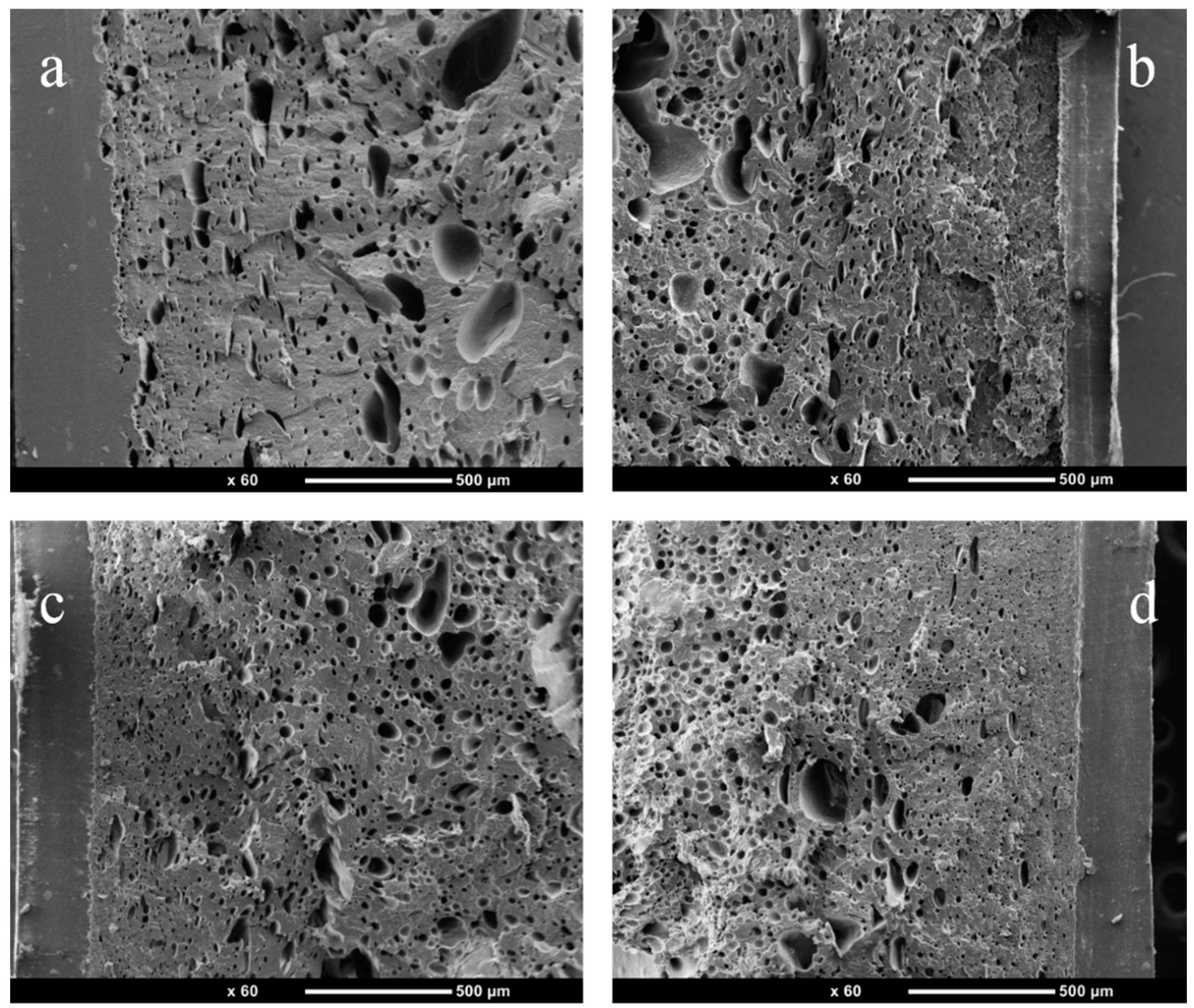
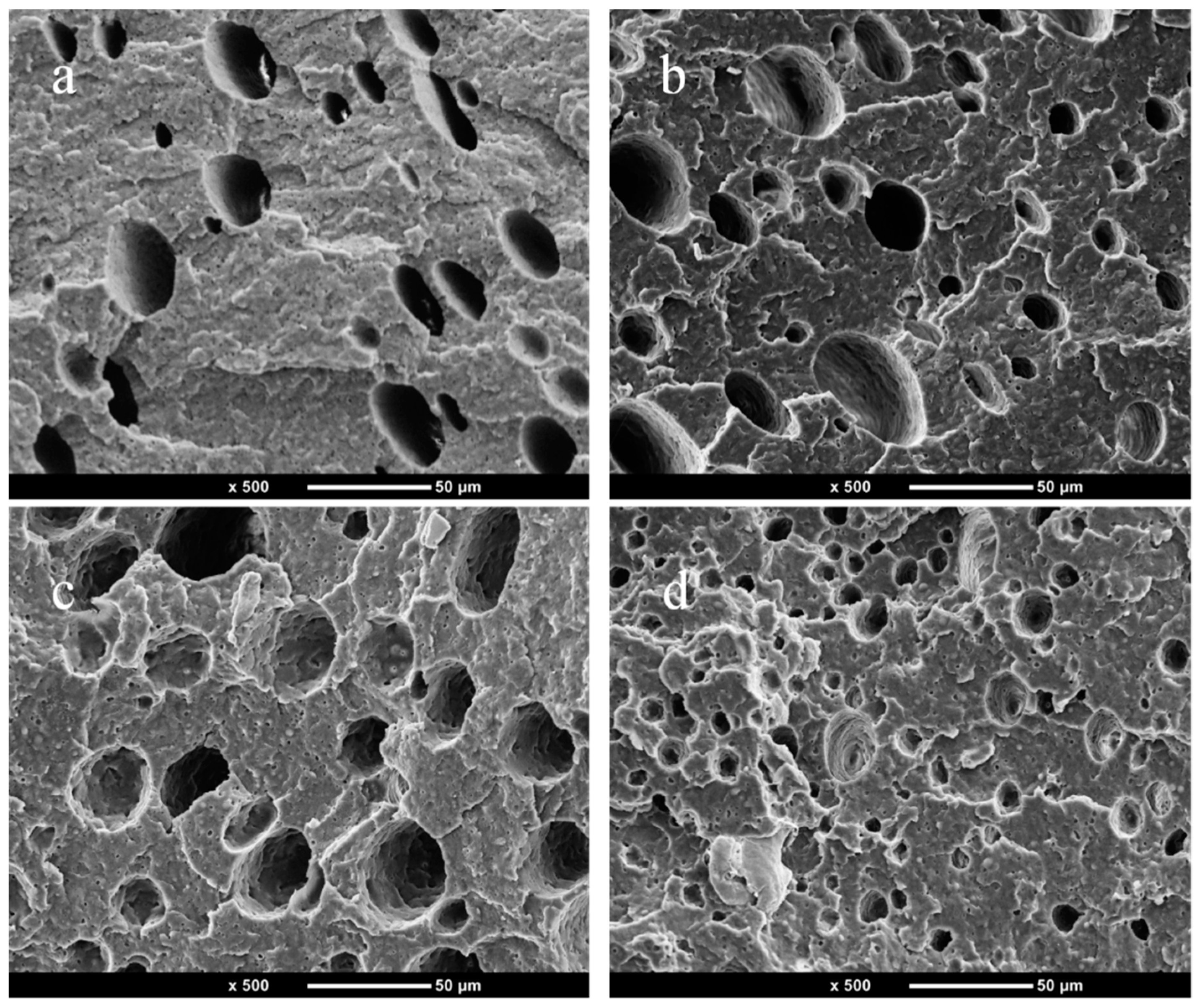

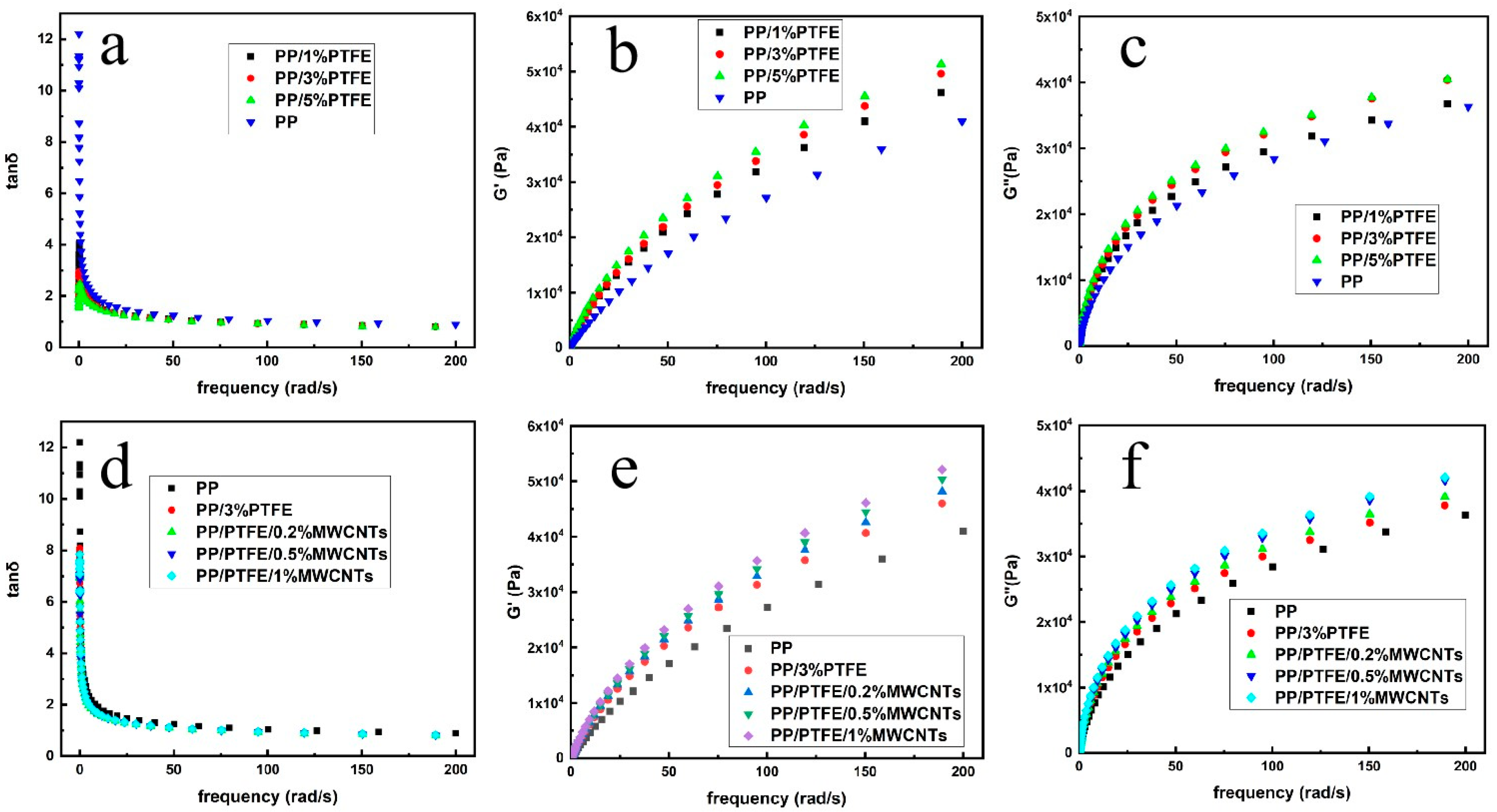
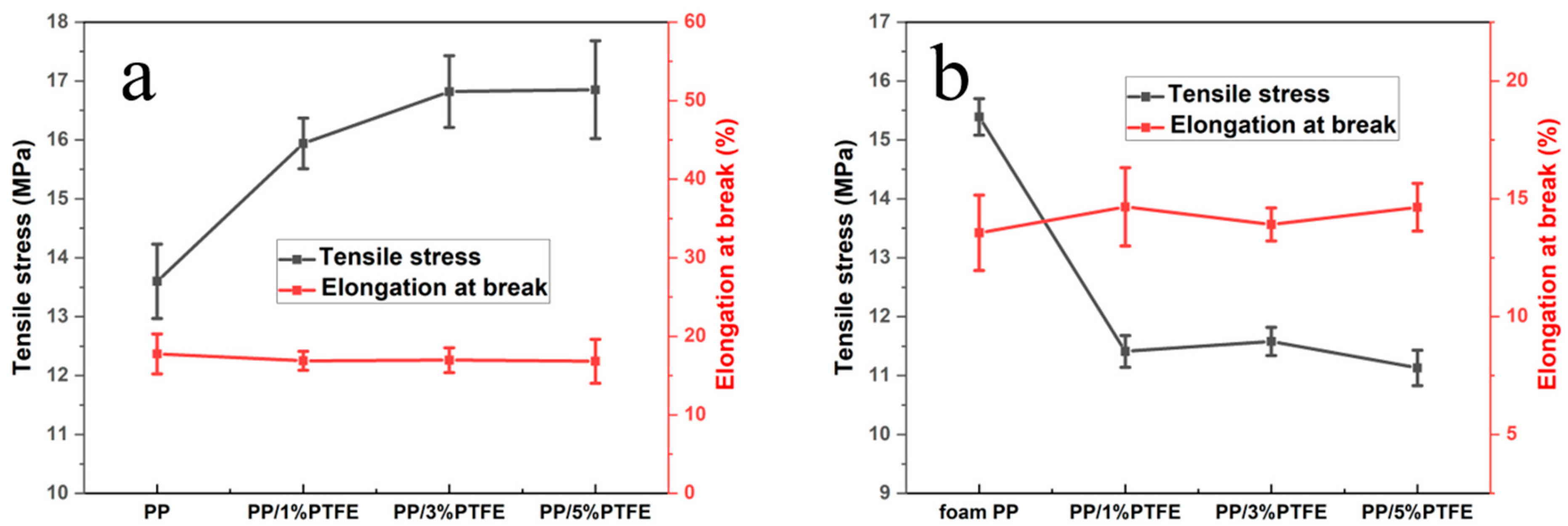

| Zone | 1 | 2 | 3 | 4 | 5 | 6 | 7 | 8 |
|---|---|---|---|---|---|---|---|---|
| Temperature (°C) | 155 | 155 | 160 | 170 | 180 | 180 | 180 | 180 |
| Masterbatch Composition | PP (wt%) | PP–g–MA (wt%) | MWCNTs (wt%) |
|---|---|---|---|
| PP/5% MWCNTs | 85.5 | 9.5 | 5 |
| Sample Formula | PP (wt%) | PTFE (wt%) | Masterbatch (wt%) |
|---|---|---|---|
| PP/PTFE | 97 | 3 | 0 |
| PP/PTFE/0.2% MWCNTs | 93.58 | 3 | 4 |
| PP/PTFE/0.5% MWCNTs | 88.45 | 3 | 10 |
| PP/PTFE/1% MWCNTs | 79.9 | 3 | 20 |
| Crystallization Temperature (°C) | Melting Temperature (°C) | ΔH (J·g−1) | Crystallinity | |
|---|---|---|---|---|
| PP | 120.6 | 168.4 | 74.64 | 35.7% |
| PP/1% PTFE | 122.5 | 165.5 | 87.58 | 41.9% |
| PP/3% PTFE | 122.7 | 165.0 | 88.95 | 42.6% |
| PP/5% PTFE | 124.3 | 165.1 | 84.35 | 40.4% |
| PP/PTFE/0.2% MWCNT | 122.2 | 166.6 | 80.03 | 38.3% |
| PP/PTFE/0.5% MWCNT | 121.5 | 166.3 | 83.23 | 39.8% |
| PP/PTFE/1% MWCNT | 122.3 | 165.7 | 84.88 | 40.6% |
| Density before Foaming (g/cm3) | Density after Foaming (g/cm3) | Expansion Ratio | |
|---|---|---|---|
| PP | 0.90 | 0.73 | 1.23 |
| PP/1% PTFE | 0.77 | 0.55 | 1.40 |
| PP/3% PTFE | 0.75 | 0.50 | 1.50 |
| PP/5% PTFE | 0.72 | 0.43 | 1.67 |
| PP/3% PTFE/0.2% MWCNTs | 0.79 | 0.40 | 1.98 |
| PP/3% PTFE/0.5% MWCNTs | 0.82 | 0.38 | 2.16 |
| PP/3% PTFE/1% MWCNTs | 0.86 | 0.35 | 2.46 |
Publisher’s Note: MDPI stays neutral with regard to jurisdictional claims in published maps and institutional affiliations. |
© 2022 by the authors. Licensee MDPI, Basel, Switzerland. This article is an open access article distributed under the terms and conditions of the Creative Commons Attribution (CC BY) license (https://creativecommons.org/licenses/by/4.0/).
Share and Cite
Li, G.; Fei, Y.; Kuang, T.; Liu, T.; Zhong, M.; Li, Y.; Jiang, J.; Turng, L.-S.; Chen, F. The Injected Foaming Study of Polypropylene/Multiwall Carbon Nanotube Composite with In Situ Fibrillation Reinforcement. Polymers 2022, 14, 5411. https://doi.org/10.3390/polym14245411
Li G, Fei Y, Kuang T, Liu T, Zhong M, Li Y, Jiang J, Turng L-S, Chen F. The Injected Foaming Study of Polypropylene/Multiwall Carbon Nanotube Composite with In Situ Fibrillation Reinforcement. Polymers. 2022; 14(24):5411. https://doi.org/10.3390/polym14245411
Chicago/Turabian StyleLi, Gang, Yanpei Fei, Tairong Kuang, Tong Liu, Mingqiang Zhong, Yanbiao Li, Jing Jiang, Lih-Sheng Turng, and Feng Chen. 2022. "The Injected Foaming Study of Polypropylene/Multiwall Carbon Nanotube Composite with In Situ Fibrillation Reinforcement" Polymers 14, no. 24: 5411. https://doi.org/10.3390/polym14245411
APA StyleLi, G., Fei, Y., Kuang, T., Liu, T., Zhong, M., Li, Y., Jiang, J., Turng, L.-S., & Chen, F. (2022). The Injected Foaming Study of Polypropylene/Multiwall Carbon Nanotube Composite with In Situ Fibrillation Reinforcement. Polymers, 14(24), 5411. https://doi.org/10.3390/polym14245411















